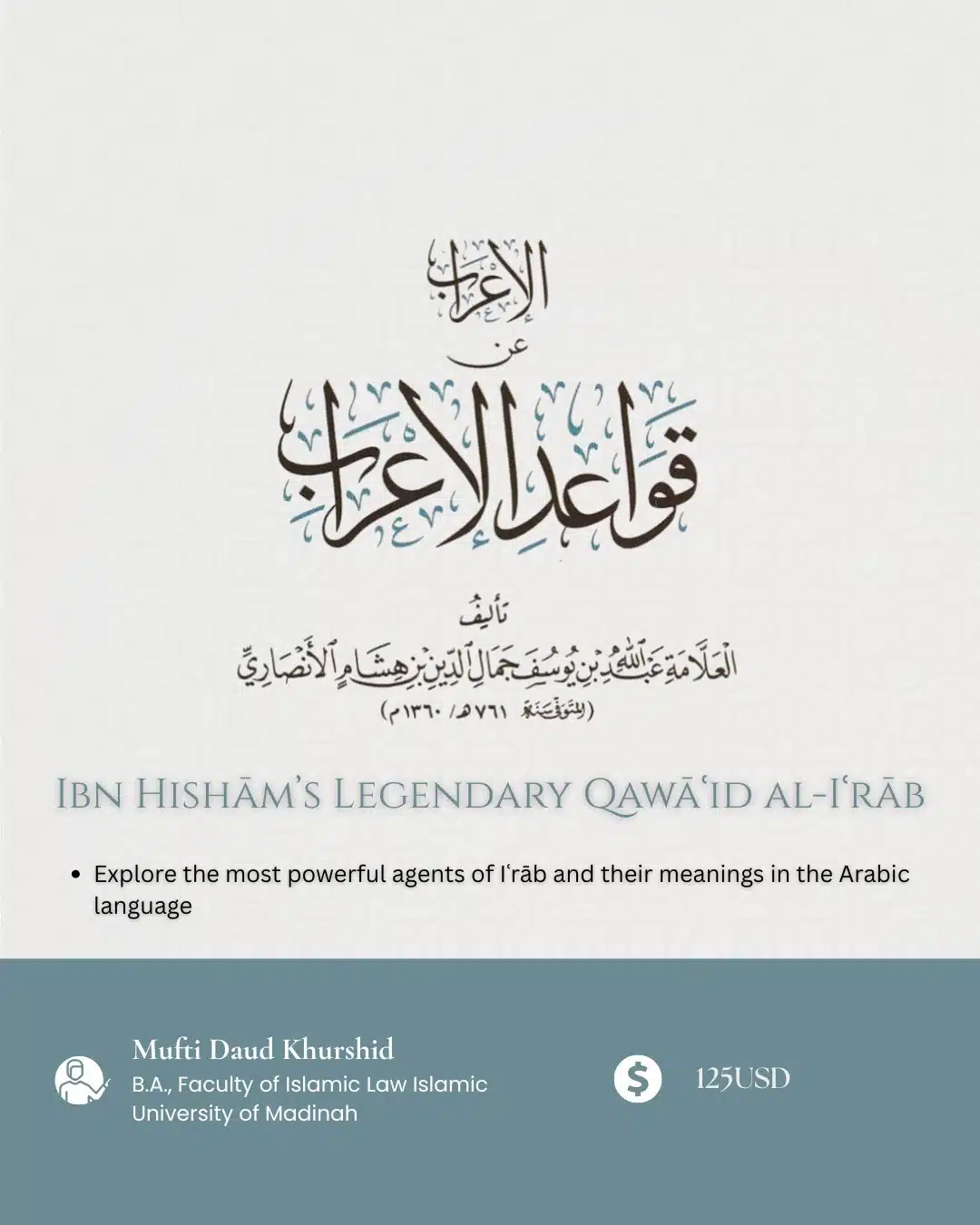A Comprehensive Gateway to Advanced ʾIʿrāb
Mastering Arabic
This course offers a detailed and structured study of al-I’rāb ʿan Qawāʿid al-I’rāb by Ibn Hishām al-Anṣārī—a foundational text designed to solidify and deepen one’s understanding of i’rāb (grammatical analysis) and its integral role in linguistic Tafsīr.
Course Overview
Comprehensive Exploration
In this intensive, we will conduct a systematic study of Qawāʿid al-I’rāb, carefully unpacking its major discussions while drawing practical examples from Qur’ānic verses and prophetic traditions. Supplementary insights and contextual explanations will be provided throughout, allowing students to grasp the precision of Ibn Hishām’s style and appreciate how nuanced grammatical structures shape the interpretation of divine texts.
Purposeful Progression
This course is uniquely designed to transition students from the foundational understanding of i’rāb—acquired through works like al-Tuḥfah al-Saniyyah, Qaṣaṣ al-Nabiyyīn, and Min Adab al-Islām—into an advanced, theoretical study. While i’rāb has until now been approached secondarily, this course treats it as a distinct science. It prepares students to:
- Engage with advanced texts on I’rāb such as I’rāb al-Qurʾān of Derwaish, al-Durr al-Masūn by al-Ḥalabī
- Pave the way to access more theoretical works in the science such as Mughnī al-Labīb
- Prepare the student to apply the theory learnt herein within our upcoming Linguistic Tafīr course, showing just how important I’rāb is in understanding divine scripture.
Target Audience
This course is intended for students who:
- Have completed a primer or more in Arabic grammar
- Are capable of reading Arabic without tashkīl (vowel markings)
- Have practiced iʿrāb or tarkīb in previous studies
Learning Outcomes
By the end of this course, students will:
- Attain a structured overview of the major rulings and discussions of i’rāb across sentence structures, prepositions (jār wa majrūr), adverbials (ẓurūf), and agents of i’rāb
- Strengthen their capacity to engage with advanced texts in both theoretical works and practical works
- Be prepared for our upcoming Linguistic Tafsīr course, where the theoretical foundations laid here will be applied directly to Qur’ānic exegesis
Course Instructor: Mufti Mohammad Daud Khurshid
The instructor has studied this entire book upon his teacher Sh. Safwān Dawūdi, who studied it upon his teacher Sh. ‘Abdul Qādir Barakah, who studied it upon his teacher Maḥmūd al-‘Aṭṭār.
About the Author
Abū Muḥammad ʿAbd Allāh ibn Yūsuf, famously known as Ibn Hishām al-Anṣārī, was a distinguished linguist, grammarian, and prolific author of the 8th century AH. He is revered as one of the most precise and influential scholars in the field of Arabic grammar. His works are characterized by clarity, precision, and a critical engagement with the grammatical traditions that preceded him.
He was born in 708 AH (1309 CE). He studied under Shihāb al-Dīn ʿAbd al-Laṭīf al-Ḥarrānī and recited the seven canonical Qur’ānic readings upon Shams al-Dīn Muḥammad ibn al-Sarrāj. Ibn Hishām excelled in all the linguistic sciences related to the Arabic language, especially syntax, morphology, and grammatical analysis.
Ibn Hishām’s literary output is extensive and methodically structured. He designed a progressive curriculum for students of Arabic grammar, beginning with introductory texts and culminating in advanced analytical works. His most prominent contributions include:
- Qaṭr al-Nadā wa-Ball al-Ṣadā along with its commentary
- Shudhūr al-Dhahab fī Maʿrifat Kalām al-ʿArab and its commentary
- Awḍaḥ al-Masālik
In the science of grammatical analysis (iʿrāb), he authored:
- al-I’rāb ʿan Qawāʿid al-I’rāb, a concise but valuable treatise around which this course is structured.
- Mughni al-Labīb ‘an Kutub al-A‘ārīb, his monumental masterpiece on the science of i’rāb, relieving him of the need to author a work of Tafsīr, due to his detailed explanation of the keys to Tafsīr.
Ibn Hishām’s writing style is marked by exceptional organization, meticulous analysis, and intellectual independence. He often diverged from earlier grammarians, including giants like Ibn Mālik and the established grammatical schools of Baṣrah and Kūfah.
His reputation extended far beyond his land in his very own era. The great historian Ibn Khaldūn famously remarked that he often heard of a scholar who had arisen in Egypt—celebrated for his mastery of Arabic—whose grammatical precision was said to exceed even that of Sībawayh. His name was Ibn Hishām!
Ibn Hishām passed away in 761 AH (1360 CE), leaving behind a legacy that shaped the study of Arabic grammar across centuries and continues to be revered in Islamic academic institutions around the world.
About the Book
Students of the Arabic language—particularly beginners—frequently seek a concise yet insightful guide to Iʿrāb. It was for such students that Ibn Hishām composed this work. In his introduction, he remarks that this book will set the thoughtful reader upon the correct path and unveil, in a remarkably short span, the subtle secrets embedded within the chapters of the Arabic linguistic tradition. He further likens his careful authorship to a devoted physician who brews a healing remedy for a beloved patient.
True to its author’s description, the book excels in clarity and conciseness. Spanning four chapters, Ibn Hishām meticulously extracts and presents nuanced points typically hidden within larger, more complex works.
- In the first chapter, he explores types of sentences—such as al-jumlah al-ṣughrā and al-jumlah al-kubrā—and identifies which sentences enjoy a position in i’rāb and which do not.
- The second chapter delves into jār wa majrūr and ẓurūf, explaining their usage as ẓarf mustaqarrand ẓarf laghw and how to analyze them, topics often overlooked in other grammar primers. Indeed, a beginner may study several texts without ever encountering these discussions or understanding them with clarity.
- The third chapter outlines twenty essential words that every student of i’rāb must know. Each word is examined with its various meanings, analytical cases, and carefully selected examples to aid comprehension.
- In the final chapter, Ibn Hishām refines the expressions commonly used in i’rāb, bringing more clear and concise terms in their place. He also compiles an excellent list of common errors made by students while studying grammatical analysis.
Although concise in length, this book serves as an ideal introduction and review of Iʿrāb—a compact treasure that gathers what is scattered across numerous works and reveals what is often left hidden in more advanced texts.
Course Curriculum
-
Telegram group for access to live classes
-
Al-I’rāb ‘an Qawā‘id al-I’rāb | Lesson 1: Introduction
40:15 -
Al-I’rāb ‘an Qawā‘id al-I’rāb | Lesson 2: The Explanation and Types of Jumlah
57:10 -
Al-I’rāb ‘an Qawā‘id al-I’rāb | Lesson 3: The Jumal that experience Mahall – 1
01:04:31 -
Al-I’rāb ‘an Qawā‘id al-I’rāb | Lesson 4: The Jumal that experience Mahall – 2
41:51 -
Al-I’rāb ‘an Qawā‘id al-I’rāb | Lesson 5: The Jumal that experience Mahall – 3
54:41 -
Al-I’rāb ‘an Qawā‘id al-I’rāb | Lesson 6: The Jumal that do not experience Mahall – 1
51:34 -
Al-I’rāb ‘an Qawā‘id al-I’rāb | Lesson 7: The Jumal that do not experience Mahall – 2
49:41 -
Al-I’rāb ‘an Qawā‘id al-I’rāb | Lesson 8: The Jumal that do not experience Mahall – 3
01:07:19 -
Al-I’rāb ‘an Qawā‘id al-I’rāb | Lesson 9: Sentences after Nakirāt and Ma’ārif
53:41 -
Al-I’rāb ‘an Qawā‘id al-I’rāb | Lesson 10: Jārr and Majrūr Part 1 | Mufti Daud Khurshid
52:57 -
Al-I’rāb ‘an Qawā‘id al-I’rāb | Lesson 11: Jārr Majūr Part 2 | Mufti Daud Khurshid
35:26 -
Al-I’rāb ‘an Qawā‘id al-I’rāb | Lesson 12: Chapter 3 Part 1 | Mufti Daud Khurshid
40:13 -
Al-I’rāb ‘an Qawā‘id al-I’rāb | Lesson 13: Chapter 3 Part 2 | Mufti Daud Khurshid
54:59 -
Al-I’rāb ‘an Qawā‘id al-I’rāb | Lesson 14: Chapter 3 Part 3 | Mufti Daud Khurshid
53:13 -
Al-I’rāb ‘an Qawā‘id al-I’rāb | Lesson 15: Chapter 3 Part 4 | Mufti Daud Khurshid
49:43 -
Al-I’rāb ‘an Qawā‘id al-I’rāb | Lesson 16: Chapter 3 Part 5 | Mufti Daud Khurshid
20:49 -
Al-I’rāb ‘an Qawā‘id al-I’rāb | Lesson 17: Chapter 3 Part 6 | Mufti Daud Khurshid
42:16 -
Al-I’rāb ‘an Qawā‘id al-I’rāb | Lesson 18: Chapter 3 Part 7 | Mufti Daud Khurshid
58:50 -
Al-I’rāb ‘an Qawā‘id al-I’rāb | Lesson 19: Chapter 4 | Mufti Daud Khurshid
48:19 -
Minah al-Wahhab fi Qawa’id al-I’rab | (Bonus) Lesson 20 | Mufti Daud Khurshid
35:09
Student Ratings & Reviews

-
LevelIntermediate
-
Last UpdatedNovember 18, 2025
-
CertificateCertificate of completion

A course by


